39 label statement sas
PDF Techniques for Labeling SAS® Variables - lexjansen.com If you have hundreds of variables, your LABEL statement can go on for pages. No one wants to type all those labels. If the text for the labels is similar or is available electroni-cally, there are better methods than typing the text in your program. In theory, there could be SAS® syntax to set ... Chow, Adam, "Macro To Put Variable Labels ... SAS : Label Statement & Rename Statement - TechnicalJockey The RENAME= options effect on where it appears : If the RENAME= option appears in the SET statement , then the new variable name takes effect when the program data vector is created . All programming statements within the DATA step must refer to the new variable name . If the RENAME= option appears in the DATA statement , then the new variable ...
Labeling | SAS Learning Modules - University of California, Los Angeles First, you must create the label formats with proc format using a value statement. Next, you attach the label format to the variable with a format statement. This format statement can be used in either proc or data steps. An example of the proc format step for creating the value formats, forgnf and $makef follows.

Label statement sas
LABEL Statement :: SAS(R) 9.3 Statements: Reference Using a LABEL statement in a DATA step permanently associates labels with variables by affecting the descriptor information of the SAS data set that contains the variables. You can associate any number of variables with labels in a single LABEL statement. You can use a LABEL statement in a PROC step, but the rules are different. Statements : LABEL - SAS Using a LABEL statement in a DATA step permanently associates labels with variables by affecting the descriptor information of the SAS data set that contains the variables. You can associate any number of variables with labels in a single LABEL statement. You can use a LABEL statement in a PROC step, but the rules are different. HBar with Data Labels - Graphically Speaking CATEGORYORDER=respdesc is used to get a graph with descending response values. Here is the SGPLOT program. title 'Actual Values by Name with Data Labels'; proc sgplot data=bars noborder noautolegend; hbar name / response=actual nostatlabel dataskin=pressed displaybaseline=auto. datalabel=name datalabelattrs= (weight=bold) datalabelfitpolicy ...
Label statement sas. How to Label Variables in SAS - SAS Example Code In SAS, you can create a variable label with the LABEL statement. You can use this statement to assign one or more labels using 3 methods, namely a SAS DATA Step, the PROC SQL procedure, and the PROC DATASETS procedure. The exact syntax of the LABEL statement depends on the method of choice. Statements : Global Statements - SAS Moves execution immediately to the statement label that is specified: IF-THEN/ELSE: Executes a SAS statement for observations that meet specific conditions: Labels, Statement: Identifies a statement that is referred to by another statement : LEAVE: Stops processing the current loop and resumes with the next statement in sequence: LINK: Jumps to ... SAS Data Set Options: LABEL= Data Set Option - 9.2 The LABEL= data set option enables you to specify labels only for data sets. You can specify labels for the variables in a data set using the LABEL statement. The LABEL= option in the ATTRIB statement also enables you to assign labels to variables. Examples These examples assign labels to data sets: data w2 (label='1976 W2 Info, Hourly'); ODS OUTPUT: Store any statistic created by any SAS procedure Jan 09, 2017 · The implications of the previous statement are monumental. I cannot overstate the importance of the OUTPUT destination, so let me say it again: The ODS OUTPUT destination enables you to store any value that is produced by any SAS procedure. You can then read that value by using a SAS program.
Statements : Labels, Statement - SAS The LABEL statement assigns a descriptive label to a variable. A statement label identifies a statement or group of statements that are referred to in the same DATA step by another statement, such as a GO TO statement. Examples In this example, if Stock=0, the GO TO statement causes SAS to jump to the statement that is labeled reorder. Statements : LINK - SAS The destination is identified by a statement label in the LINK statement. The LINK statement can branch to a group of statements that contains another LINK statement. This arrangement is known as nesting. To avoid infinite looping, SAS has set a maximum on the number of nested LINK statements. SAS Help Center Using a LABEL statement in a DATA step permanently associates labels with variables by affecting the descriptor information of the SAS data set that contains the variables. You can associate any number of variables with labels in a single LABEL statement. Comparisons Statements: LABEL Statement - 9.2 - SAS Using a LABEL statement in a DATA step permanently associates labels with variables by affecting the descriptor information of the SAS data set that contains the variables. You can associate any number of variables with labels in a single LABEL statement. You can use a LABEL statement in a PROC step, but the rules are different.
SAS(R) 9.2 Language Reference: Dictionary, Fourth Edition Provides comprehensive reference information for the Base SAS language, which is available in all operating environments that support SAS. This document is organized by data set options, formats, functions and CALL routines, informats, statements, system options, and component options. Suppress variable labels in SAS procedures - The DO Loop Now, I'm sure that the procedure "means" well (pun intended), but I don't need to see the labels for these variables. I can probably remember that the SepalLength variable is a measurement of the "Sepal Length"! On a whim, I searched for the terms "PROC MEANS" and "NOLABEL" and—Awesome!—was led to a SAS Knowledge Base article entitled "New option to suppress variable labels in PROC MEANS." SAS Help Center Using a LABEL statement in a DATA step permanently associates labels with variables by affecting the descriptor information of the SAS data set that contains the variables. You can associate any number of variables with labels in a single LABEL statement. You can use a LABEL statement in a PROC step, but the rules are different. Solved: proc print display label - SAS Support Communities Please read the PROC PRINT documentation, when you have a LABEL statement in your code, you need to tell PROC PRINT to USE the LABEL with the LABEL option in your PROC PRINT statement: proc print data=mydata label; or proc print data=mydata split='_'; Either the LABEL or the SPLIT option tells PROC PRINT to use the LABEL for the data.
Add horizontal and vertical reference lines to SAS graphs: The … Apr 13, 2020 · You can also use the BLOCK statement to show the cholesterol ranges. Reference lines at computed locations. Sometimes the reference values are the result of a computation. The REFLINE values and the LABEL= option can come from variables in a SAS data set. For multiple values, you probably want to arrange the values in "long form."
SAS/GRAPH Statements: AXIS Statement Note, however, that if you simultaneously request automatic labeling with a PLOT or BUBBLE statement (using the AUTOHREF or AUTOVREF option), then the automatic labeling can write on top of the custom label you specified using the AXIS statement. You must ensure that your custom labels specified using the AXIS statement are not at the same position as automatic …
Macro Statements: %label Statement - SAS An alternative to using the %GOTO statement and statement label is to use a %IF-%THEN statement with a %DO group. Example Example 1: Controlling Program Flow In the macro INFO, the %GOTO statement causes execution to jump to the label QUICK when the macro is invoked with the value of short for the parameter TYPE.
'label' Statement - Boston University When a label statement is placed in a data step, the label stays with the variable for all subsequent procedures, unless relabeled. When placed in a procedure the label only stays attached to the variable for that procedure. Use double quotes if there is to be a single quote in the label. For example, label mombp="mother's systolic bld pressure";
40 Most Common SAS Statements, Functions and Procedures 16 Free Resources to help you learn SAS (updated 2021) A Complete SAS Tutorial for Beginners; How to Learn SAS Fast; Data Import. How to Import Excel Spreadsheet into SAS; How to Import CSV Files into SAS; How to Import Text Files into SAS; SAS Functions. The CAT, CATT, CATS, CATX functions in SAS; If-Then-Else Statement in SAS
Automating SAS variable labels creation - SAS Users The most direct way of creating column labels is by explicitly assigning them to the data variables. You can do it during the data table creation in a DATA step using either LABEL statement or ATTRIB statement. Alternatively, you can do it after your data table is already created by using PROC DATASETS' MODIFY statement with the LABEL= option.
SAS Help Center The statement label identifies a statement or group of statements that are referred to in the same DATA step by another statement, such as a GO TO statement. Examples Example 1: Jumping to Another Statement In this example, if Stock=0, the GO TO statement causes SAS to jump to the statement that is labeled reorder.
SAS Help Center SAS® 9.4 DATA Step Statements: Reference documentation.sas.com. SAS® Help Center. Customer Support SAS Documentation. SAS® 9.4 and SAS® Viya® 3.5 Programming Documentation ... LABEL Statement. Label: Statement. LEAVE Statement. LENGTH Statement. LIBNAME Statement. LIBNAME Statement: CVP Engine.
SAS Help Center Label statements can be used in a DATA step and within some PROC steps. If a label is assigned to a variable in a DATA step or in PROC DATASETS, the label is permanently assigned in the output data set descriptor. Some PROCs, such as PROC PRINT, can temporarily associate a label with a variable for use during the procedure.
LABEL Statement :: SAS/ETS(R) 13.1 User's Guide The LABEL statement assigns SAS variable labels to variables in the output data sets. You can give labels for any number of variables in a single LABEL statement. The default labels for variables depend on the file type. Extra-long labels ( > 256 bytes ) reside in the OUTCONT data set as the DESCRIPT variable.
Effective Use of RETAIN Statement in SAS Programming - MWSUG We must make sure the RETAIN statement occurs before the SET statement. Consequently, the variables in the RETAIN statement are positioned first (leftmost) in the PDV and the output data set. CONCLUSION • We use the RETAIN statement when we want SAS to preserve a variable's value from the previous iteration of the DATA step. As a result, we ...
Data Set Options : LABEL= - SAS OnlineDoc, V8 Details. You can use the LABEL= option on both input and output data sets. When you use LABEL= on input data sets, it assigns a label for the file for the duration of that DATA or PROC step. When it is specified for an output data set, the label becomes a permanent part of that file and can be printed using the CONTENTS or DATASETS procedure ...
6.7 - Descriptive Labels | STAT 480 - PennState: Statistics Online Courses In order to label the columns in your report as such, you need to use: a LABEL statement to assign a descriptive label to a variable, and. the LABEL option in the PROC PRINT statement to specify that labels, rather than variable names, be displayed. The LABEL statement can be placed either in a DATA step or directly in the PRINT procedure.
Generating multiline axis labels in SAS PROC SGPLOT | SAS … The variable names in the input statement should be copied as is, as SAS expects certain variable names to be used as options for our annotation. The options we specify are: function a string variable that defines what type of annotation this entry is; here we specify a text annotation; other possible are line, image, polygon, arrow, etc. x1 where along the x-axis to place the annotation; …
What statistical analysis should I use?Statistical analyses using SAS The desc option on the proc logistic statement is necessary so that SAS models the probability of being female (i.e., female = 1). The expb option on the model statement tells SAS to display the exponentiated coefficients (i.e., the odds ratios). proc logistic data = "c:/mydata/hsb2" desc; model female = read write / expb; run;
HBar with Data Labels - Graphically Speaking CATEGORYORDER=respdesc is used to get a graph with descending response values. Here is the SGPLOT program. title 'Actual Values by Name with Data Labels'; proc sgplot data=bars noborder noautolegend; hbar name / response=actual nostatlabel dataskin=pressed displaybaseline=auto. datalabel=name datalabelattrs= (weight=bold) datalabelfitpolicy ...
Statements : LABEL - SAS Using a LABEL statement in a DATA step permanently associates labels with variables by affecting the descriptor information of the SAS data set that contains the variables. You can associate any number of variables with labels in a single LABEL statement. You can use a LABEL statement in a PROC step, but the rules are different.
LABEL Statement :: SAS(R) 9.3 Statements: Reference Using a LABEL statement in a DATA step permanently associates labels with variables by affecting the descriptor information of the SAS data set that contains the variables. You can associate any number of variables with labels in a single LABEL statement. You can use a LABEL statement in a PROC step, but the rules are different.












![SAS Statement] label: 구문(구문 레이블)](https://blog.kakaocdn.net/dn/b4y5m6/btrsnJYUEH4/e5dzQgRLHWwJlNIM7s0S00/img.jpg)
![PDF] A Closer Look at PROC SQL's FEEDBACK Option | Semantic ...](https://d3i71xaburhd42.cloudfront.net/2dc981bd9bed71a082d25e7c5da9d71bcd498af2/6-Figure6-1.png)

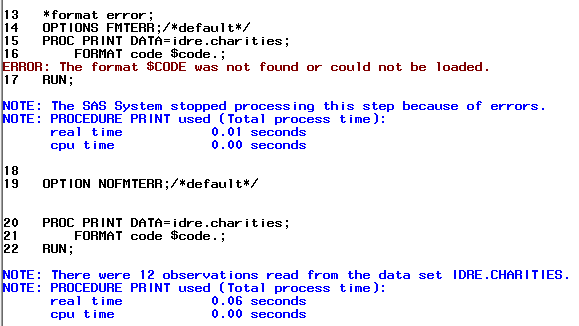
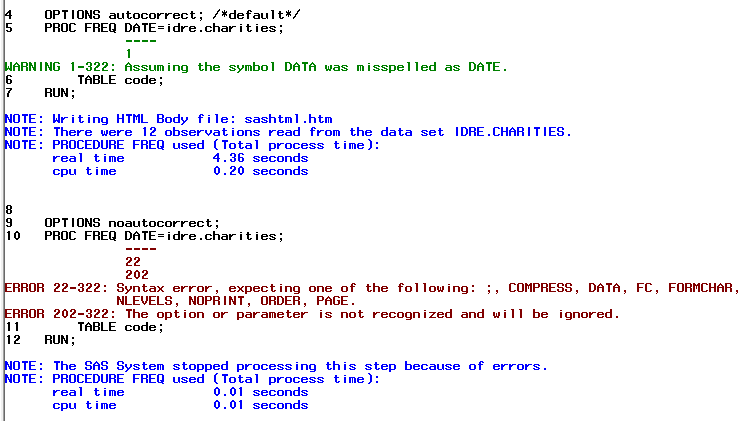
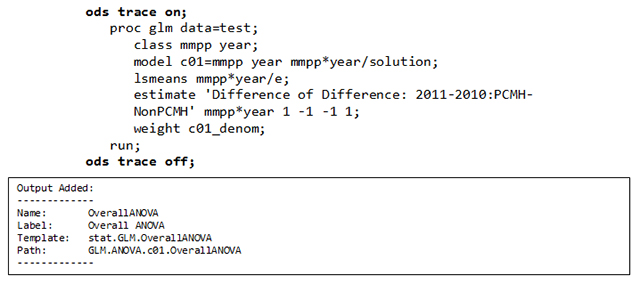


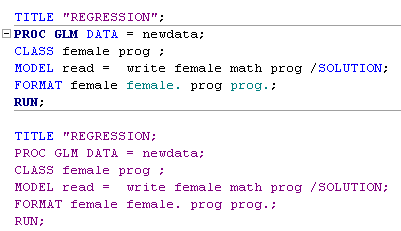




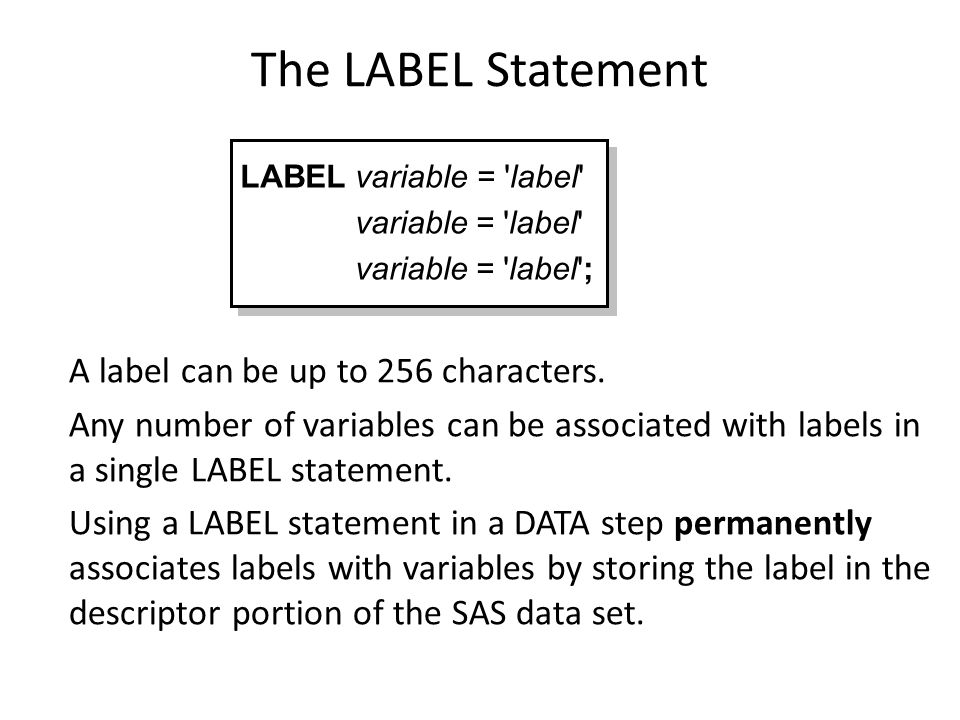

Post a Comment for "39 label statement sas"